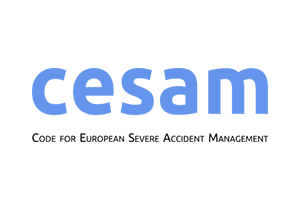
The Fukushima accidents highlighted that both the in-depth understanding of such sequences and the development or improvement of adequate severe accident management measures is essential in order to further increase the safety of the nuclear power plants operated in Europe. CESAM (Code for European Severe Accident Management) is a R&D project that aims in particular at the improvement of the European reference code ASTEC towards a usage in severe accident management analysis for nuclear power plants (NPP).
The models of ASTEC that are available for the relevant phenomena during severe accidents in the reactor core as well as in the spent fuel ponds are assessed and recommendations for improvement are developed. The lessons learned from the severe accident in Fukushima will be especially considered. Based on these recommendations ASTEC models will be improved and validated by the partners.
In addition, ASTEC will be coupled to environmental consequences tools and a methodology will be investigated that evaluates the probability of different possible accident scenarios based on available on-side data during an accident in a nuclear power plant. This way, ASTEC will be extended to become a tool used for decision-making in emergency cases.
ASTEC reference datasets for the main generic types of NPPs in Europe (PWR, BWR, CANDU) will jointly be prepared to give users appropriate guidance how to apply ASTEC for real plant analyses used e.g. for accident management. Plant analyses and possible improvements of SAM measures based on various plant scenarios and accounting for the lessons drawn from the Fukushima accidents, will be performed. A workshop will be organized to elaborate on ASTEC capabilities for calculations of the Fukushima accidents, both in the reactor core and the spent fuel ponds.
LEI activities in the Project 2015-2016
In 2015, Laboratory experts together with project partners collected necessary information for creating models of a spent nuclear fuel pool. The collected information is summarized in the report published by Swiss partners (PSI – Paul Scherrer Institut). For benckmark calculations during implementation of the project, two accidents have been chosen: water evaporation due to boiling and loss of coolant. Laboratory experts created an initial model of a spent nuclear fuel pool using ICARE module of ASTEC V2.0 software code, which during the project will be replaced by a model created by CESAM and ICARE modules of ASTEC V2.1 software code. The initial model of the spent fuel pool of the same type was also created using RELAP/SCDAPSIM software code. Since used software codes do not always apply the same correlations for modelling processes occurring during severe accidents, in 2015, the sets of initial, boundary conditions and applicable correlations in models created by ASTEC and RELAP/SCDAPSIM software codes were discussed. While modelling processes in spent fuel pools, the uncertainties are inevitable. Therefore, Laboratory experts discussed modelling uncertainty and its possible influence on the results of the numerical research.
In 2016, the creators of the software package submitted several updated versions for software code ASTEC, therefore Laboratory specialists modified the earlier developed GE BWR4-Mark I type power plant model, taking into account the updates of ASTEC V2.1.0.5 version. Also the laboratory researchers updated the earlier created BWR type spent fuel pool model. Using the improved GE BWR4-Mark I type power plant model the water loss calculations were carried out, which were compared with the results obtained using RELAP/SCDAPSIM for that.
Total cost of Project: 6 258 591,40 EUR (LEI part: 180 000,00 EUR)
Coordinator: GESELLSCHAFT FUER ANLAGEN- UND REAKTORSICHERHEIT (GRS) MBH, Germany
Project partners:
- GESELLSCHAFT FÜR ANLAGEN- UND REAKTORSICHERHEIT MBH (GRS), Germany
- INSTITUT DE RADIOPROTECTION ET DE SÛRETÉ NUCLÉAIRE (IRSN), France
- KARLSRUHE INSTITUTE OF TECHNOLOGY (KIT), Germany
- CENTRO DE INVESTIGACIONES ENERGETICAS MEDIO AMBIENTALES Y TECNOLOGICAS (CIEMAT), Spain
- AGENZIA NAZIONALE PER LE NUOVE TECNOLOGIE, L’ENERGIA E LO SVILUPPO ECONOMICO SOSTENIBILE (ENEA), Italy
- VUJE TRNAVA, A.S (VUJE), Slovakia
- INZINIERSKA VYPOCTOVA SPOLOCNOST TRNAVA S.R.O. (IVS), Slovakia
- LITHUANIAN ENERGY INSTITUTE (LEI), Lithuania
- NUBIKI NUCLEAR SAFETY RESEARCH INSTITUTE (NUBIKI), Hungary
- UNIVERSITÄT STUTTGART (USTUTT), Germany
- RUHR-UNIVERSITÄT BOCHUM (RUB), Germany
- INSTITUTE FOR NUCLEAR RESEARCH AND NUCLEAR ENERGY (INRNE), Bulgaria
- JOZEF STEFAN INSTITUTE (IJS), Slovenia
- JOINT RESEARCH CENTRE (JRC), Belgium
- VTT TECHNICAL RESEARCH CENTRE OF FINLAND (VTT), Finland
- AREVA NP SAS (AREVA), France
- PAUL SCHERRER INSTITUT (PSI), Switzerland
- BHABHA ATOMIC RESEARCH CENTRE (BARC), India
- ELECTRICITÉ DE FRANCE (EDF), France
Project Team
| Name, surname | Office | phone. | |
|---|---|---|---|
|
LEI Representative |
|||
| Virginijus Vileiniškis | 251-AK | +37037401928 | Virginijus.Vileiniskis@lei.lt |
|
Project Team |
|||
| Sigitas Rimkevičius | 424-AK | +37037401924 | Sigitas.Rimkevicius@lei.lt |
| Eugenijus Ušpuras | |||
| Algirdas Kaliatka | 406-AK | +37037401903 | Algirdas.Kaliatka@lei.lt |
| Egidijus Urbonavičius | 405/1-AK | +37037401914 | Egidijus.Urbonavicius@lei.lt |
| Mindaugas Vaišnoras | 414-AK | +37037401954 | Mindaugas.Vaisnoras@lei.lt |
| Raimondas Pabarčius | 409-AK | +37037401919 | Raimondas.Pabarcius@lei.lt |
| Aurimas Tonkūnas | |||
| Viktoras Ognerubovas | |||
| Tadas Kaliatka | 415-AK | +37037401911 | Tadas.Kaliatka@lei.lt |
| Tomas Kačegavičius | 250-AK | +37037401836 | Tomas.Kacegavicius@lei.lt |
| Mantas Povilaitis | 254-AK | +37037401920 | Mantas.Povilaitis@lei.lt |
| Aurimas Kontautas | |||





